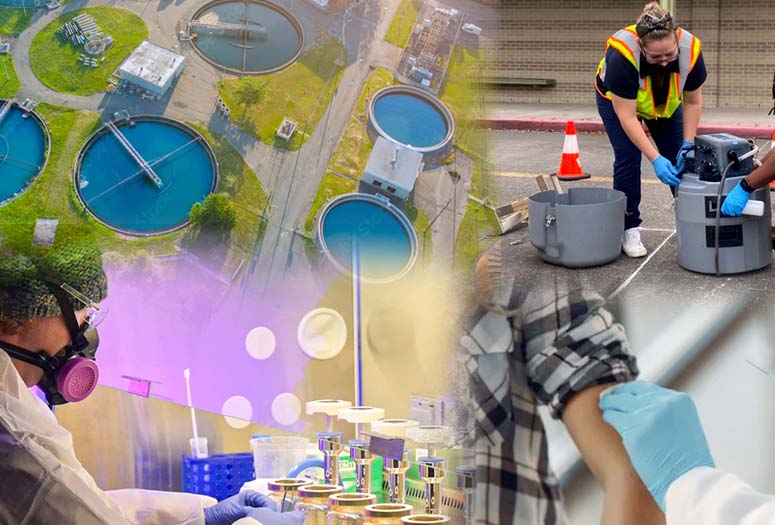
Before the COVID-19 pandemic, city wastewater analysis was primarily focused on sampling to ensure the removal of pollutants before releasing treated water back into the environment.
The science and innovation behind testing and tracking the prevalence of SARS-CoV-2, the virus that causes COVID-19, in sewersheds has demonstrated significant potential for continuous monitoring for more communicable illnesses and in helping guide public health responses.
In building an internal action plan tailored by pathogen type after detection in wastewater, the Houston Health Department worked with subject matter experts, infectious disease physicians, and collaborators with Houston Wastewater Epidemiology – a Center of Excellence by the Centers for Disease Control and Prevention (CDC) and the National Wastewater Surveillance System Center of Excellence (NWSS).
The internal response framework draws from crucial work during the COVID-19 pandemic and serves as a guide to expanding wastewater sampling and monitoring in Houston.
“Pathogens are widely diverse and can cause illnesses that range from mild to severe with different treatment and prevention options,” said Loren Hopkins, chief environmental science officer for the City of Houston and bureau chief of the Houston Health Department’s Data Science Division, a program that was initiated at the start of the pandemic.
The framework was published online in the journal Public Health Reports by Hopkins and co-authors, including Houston Health Department Director Stephen Williams; Analyst Komal Sheth and Senior Analyst Kaavya Domakonda; Bureau Chief of Epidemiology Kirstin Short; Dr. David Persse, the public health authority and EMS director for the City of Houston; and Catherine Johnson of the Houston Health Foundation and Texas Children's Hospital.
Modern technologies, such as next-generation sequencing and qualitative and quantitative data analysis, provide new insights into using wastewater-based epidemiology to detect and monitor more pathogens in real-time.
The Houston Health Department and collaborators with Houston Wastewater Epidemiology are working with an advisory committee of local infectious disease physicians and public health specialists to prioritize an additional 29 potential pathogens to the wastewater surveillance target list.
To date, Houston’s wastewater surveillance system has regularly monitored SARS-CoV-2 and variants of concern, influenza A and B, mpox, and respiratory syncytial virus (RSV). Reports can be found on the City of Houston Wastewater Monitoring Dashboard.
“Managing wastewater data generated by multiple targets and using it to develop effective strategies is a complicated process,” said Hopkins, who is also a professor in the practice of statistics at Rice University and has taught several courses in environmental risk assessment and human health.
“Wastewater monitoring programs can generate large volumes of data, and once useful information is extracted, appropriate response frameworks need to be established to ensure timely and efficient responses that are based on the severity of pathogen detections,” said Hopkins.
Building the framework for detection and response to multiple infectious diseases of interest began in July 2023, when Hopkins and paper co-authors Domakonda and Sheth began meetings with health department bureau chiefs and program managers in epidemiology, immunization, and health education programs.
Domakonda, who has 20 years of experience in spearheading environmental health initiatives for the Houston Health Department, recalls lessons learned from the COVID-19 pandemic. “Collective action through timely and efficient communication and targeted responses were critical to controlling outbreaks,” she said. “In moving forward, we are creating advanced plans to strengthen public health preparedness, prevention, and response capacities and capabilities.”
The Houston Health Department, in collaboration with academic partners at Rice University, conducted a hypothesis-generating study in which infectious disease subject matter experts from 21 different states, primarily in large cities or counties, suggested potential targets.
The feasibility study, published in the journal Emerging Infectious Diseases on August 30, 2024, addresses criteria recommended by the National Academies of Sciences, Engineering, and Medicine for selecting wastewater targets.
“There are many factors that affect timelines and appropriateness of actions based on pathogen detection that include the type of pathogen and its characteristics and the need for citywide or facility-level responses,” said Sheth, who was the first author of both papers published this summer.
In the city-wide response framework, wastewater sampling locations include wastewater treatment plants and/or lift stations or manholes. The facility-level response framework is considered more actionable because sampling locations can include targeted nursing homes, schools, homeless shelters, and jails as needed.
Communicable illnesses such as seasonal influenza can cause mild to severe illnesses, but primarily affect people with weakened immune systems. Candida auris (C. auris), an emerging fungal pathogen that spreads easily among patients in healthcare facilities, can cause severe illness and is often resistant to antifungal medications.
Positive detections for C. auris and influenza at large urban wastewater treatment plants might not trigger special action by a public health agency. Detections of C. auris in a manhole dedicated to a nursing home or influenza and other respiratory viruses at a school would trigger appropriate public health interventions.
The technology for analyzing and interpreting wastewater data is novel. Rice University environmental engineer Lauren Stadler and statistician Katherine Ensor will continue to play a crucial role in the increased scope of assay development and computational analysis to evaluate the feasibility of pathogen detection in wastewater samples.
- Shawn Hutchins, Communications Specialist

